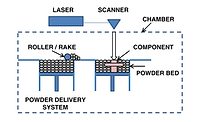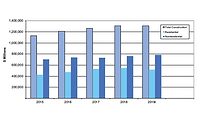Strategic Solutions
Third-Party Validation of Adhesive Performance
This second installment of a two-part series higlights the value proposition of independent material testing and validation to high-value end-use markets.

Figure 1. The effect of relative humidity and temperature on bonding strength for a two-component acrylic (left) and moisture-cure urethane (right).

Figure 2. Temperature and relative humidity effects on application dynamics.


Independent testing and third-party validation of application-specific and customer-required adhesive products are expected across the value chain. It is especially important to validate adhesive performance for the electronics industry. Adhesive manufacturers often provide the results of their own laboratory testing initially to the customer (then to a third-party laboratory) for validation.
When a customer doesn’t have internal laboratory resources to validate its suppliers’ research findings, it relies on a third-party laboratory (university or commercial testing facility) to provide a certified report validating materials, methods, and repeatable results. Meeting a military-grade requirement or MIL standard requires that both the supplier and its adhesive product be vetted by various U.S. Department of Defense agencies.
Pilot Runs on Customer Production Lines
Following the completion of pilot testing performed in its own laboratory, the adhesive manufacturer will scale up to run its formulation on its customer’s production line for a few hours. By agreeing to the pilot run, the OEM is, at minimum, trading off the cost of interrupted production time in exchange for an added layer of quality assurance: the newly specified adhesive product is validated as compatible with OEM production processes and substrates. The pilot run validates that the adhesive and bond characteristics perform according to the customer’s requirements and expectations, and that the application and curing dynamics are suitable.
If the pilot run on the OEM’s production line is deemed successful by all parties, the adhesive product will likely be purchased and fully implemented into production by the customer. If, however, the pilot run fails or complications arise, the supplier’s investment to date in acquiring the customer’s business is unnecessarily put at risk, should the customer opt to switch suppliers or substitute another adhesive product. Less measurable, but equally important, the adhesive manufacturer’s credibility may be called into question—not only by one customer, but by an entire end-use market.
Mitigating these potential risks is one aspect of qualified third-party testing’s value proposition, particularly to the adhesive manufacturer. Ideally, the third party should have the ability and resources to conduct the pilot run in a testing environment that simulates the customer’s production line, equipment, and atmospheric conditions. How to best simulate a customer’s atmospheric conditions, as well as the criteria used, is central to obtaining a consistent, specification-driven bond with factory-applied adhesives. Not only do customers’ atmospheric conditions vary, but so do their application requirements for curing (fast vs. slow cure), short vs. long adhesive pot life, and customized and/or hybrid adhesive products. All third-party testing capabilities and laboratory equipment differ, which the customer has to factor in when pursuing third-party validation.
Temperature and Relative Humidity Effects
An adhesive’s application and curing dynamics are rarely quantified over a wide range of varying climactic conditions in a conventional laboratory setting, yet this information is critical to the final performance of the structural bond. Understanding the performance of adhesive products under the extreme humidity and temperature conditions experienced during application in a manufacturing plant located in the southern U.S. during the summer months, for example, is critical for consistent bonding results.
Both relative humidity and temperature play a considerable role on surface energy, rheology dynamics, film formation, curing dynamics, and the final performance of the cured adhesive. Figure 1 highlights the effect of relative humidity and temperature on bonding strength for a two-component acrylic adhesive and a moisture-cure urethane.
Substrate Dynamics
Moisture can lead to corrosion on a metal substrate, as well as poor film formation and adhesion. If the temperature of the substrate is lower than the dew point of the surrounding air, moisture will condense onto the substrate. Best practice is to ensure that the temperature of the substrate is at least 3-5˚F above the dew point of the air. The presence of moisture on the surface can lead to significant problems, including:
- Flash rusting and initiation of the corrosion process (reduced corrosion resistance)
- Changes to the free energy of the surface, leading to changes in wettability, film formation, and interfacial tension
- Evaporation of water during curing, which can lead to blistering
- Loss of adhesion
- Degraded chemical resistance
Application Dynamics
When spray-applying adhesives, the fineness and consistency of the atomized droplets are critical factors in the wetting of the surface and the formation of a continuous, uniform film. The body of air is represented by three parameters: air velocity, temperature, and relative humidity. As illustrated in Figure 2, the dynamics of the droplet are defined by:
- Drop size (radius)
- Drop temperature
- Viscosity and surface tension
- Drop velocity
- Rate of evaporation at surface
- Heat conduction and convection inside the drop
- Water content, solids, and solvent content
Curing Dynamics
A waterborne adhesive system that is applied in high-humidity factory conditions may fail to cure uniformly due to slow water evaporation. Conversely, low humidity may speed up water evaporation, allowing insufficient time for coalescing and proper film formation. Rapid curing may also lead to cracking and skinning.
In a one-component moisture-cure system, such as polyurethane (MCU), silicone, and cyanoacrylate, low humidity can lead to prolonged curing time or partial curing, while high humidity can cause rapid skinning and limit the workability window of the adhesive material. In two-component epoxies, amines are water sensitive; an amine that reacts with water and carbon dioxide may produce ammonium carbamate, which can compromise the adhesive cure and lead to blushing.
Environmental Simulation
Wide variations in temperature and relative humidity based on seasonal and daily fluctuations are common in a factory, even during an 8-hr shift. Performance testing for every possible climate variation would be cost prohibitive without the proper testing chamber.
In addition, market forces are driving innovations in chemistries and substrate materials that will only increase bonding challenges. Application testing of materials in an environment that simulates a wide range of environmental conditions can ensure the proper performance window for existing chemistries while facilitating the introduction of more robust materials and formulations to perform over larger application windows.
Looking for a reprint of this article?
From high-res PDFs to custom plaques, order your copy today!









